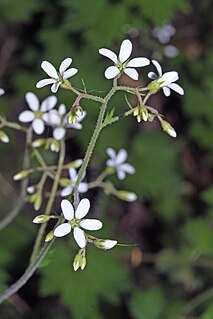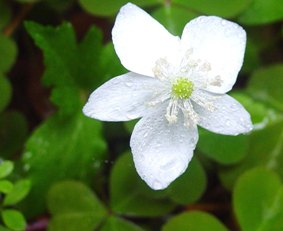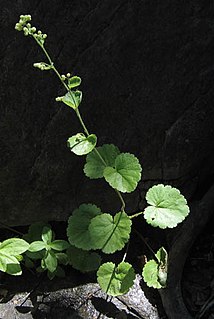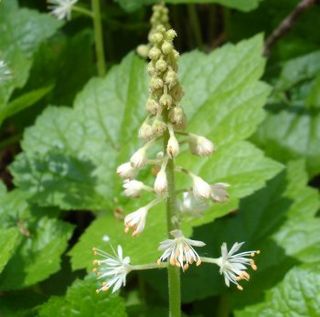
Platanus racemosa is a species of plane tree known by several common names, including California sycamore, western sycamore, California plane tree, and in North American Spanish aliso. Platanus racemosa is native to California and Baja California, where it grows in riparian areas, canyons, floodplains, at springs and seeps, and along streams and rivers in several types of habitats. It has been found as far north as Tehama and Humboldt counties.

The long-eared chipmunk, also called the Sacramento chipmunk or the four-banded chipmunk, is a species of rodent in the squirrel family, Sciuridae. It is endemic to the central and northern Sierra Nevada of California and Nevada in the United States. Long-eared chipmunks have the longest ears of all species of chipmunks.

Boykinia is a small genus of plants related to the saxifrages. It contains at least nine species, known as brookfoams. Brookfoams are glandular rhizomatous creeping perennials with highly lobed or toothed leaves and inflorescences of petite flowers. They are native to North America and Asia.

Geranium oreganum is a species of geranium known by the common name Oregon cranesbill, or Oregon geranium. It is native to western North America from California to Alberta, where it grows in mountain forests and meadows. This is a perennial herb growing generally erect to heights of 40 to 80 centimeters. The slender stems have a foliage of large palmate leaves up to 15 centimeters wide and divided into several segments, each of which is subdivided into rounded or pointed lobes. The flower has pointed sepals beneath rounded lavender to purple petals. The fruit has a small body with a pointed style column up to five centimeters long.
Iliamna latibracteata is an uncommon species of flowering plant in the mallow family known by the common names California globe mallow and California wild hollyhock.

Ivesia lycopodioides is a species of flowering plant in the rose family known by the common name clubmoss mousetail, or clubmoss ivesia. It is native to the Sierra Nevada and to regions east of the range in California. It may also be found beyond the state line into Nevada. This is a perennial herb which grows in the crevices of rock ledges in the mountains and in wet high-elevation meadows. It produces a rosette of flat to cylindrical leaves up to 15 centimeters long, each of which is made up of many tiny, lobed leaflets. The stems may grow erect or drooping to 30 centimeters long and each holds an inflorescence of clustered flowers. Each flower has hairy, greenish triangular sepals and much larger oval-shaped petals of bright yellow. In the center of the flower are usually five stamens and several pistils. There are three subspecies.

Anemone deltoidea is a species of flowering plant in the buttercup family known by the common names Columbian windflower and western white anemone. It is native to the forests of the west coast of the United States. This is a rhizomatous perennial herb growing between 10 and 30 centimeters tall. There is usually a single basal leaf which is divided into three large toothed leaflets, each up to 6 centimeters long. There may be more leaves along the mostly naked stem which are similar in appearance to the leaflets on the basal leaf. The inflorescence has three leaflike bracts and a single flower. The flower has no petals but five petal-like white sepals each one to two centimeters long. There are up to 120 whiskery stamens and many pistils. The fruit is a cluster of spherical achenes.

Aquilegia eximia is a species of columbine known by the common names serpentine columbine or Van Houtte's columbine. It is endemic to California, where it grows in the moist forests of the Coast Ranges. This is a perennial herb growing from a thick caudex and varying in height, reaching a maximum height near 1.5 meters. The lower leaves are divided into large, leaflike segments up to 4 or 5 centimeters long and a lobed oval in shape. Leaves farther up the stem are not segmented but may be deeply lobed. The inflorescence bears a large, nodding columbine flower. Each flower has five bright red to orange-red flat sepals up to nearly 3 centimeters long, and five petals which are hollow spurs up to 4 centimeters long, bright orange-red on the outer surface and lighter orange to yellow inside. The mouth of each hollow petal tube is up to a centimeter wide. The sepals and petals are generally reflexed back toward the stem and the five pistils and many thin stamens extend forward from the center of the flower.

Boykinia occidentalis is a species of flowering plant in the saxifrage family known by the common name coastal brookfoam. It is native to the west coast of North America from British Columbia to California, where it grows in shady areas near riverbanks and streams. It is a rhizomatous perennial herb producing large, rounded leaves with blades up to 45 centimeters long and 12 wide, borne on petioles up to 30 centimeters in length. Each leaf has several rounded lobes with dull teeth along the edges. The inflorescence reaches 30 to 60 centimeters tall on a thin stem. It bears an open array of many small white flowers, each with five tiny pointed sepals and five larger oval petals.

Boykinia rotundifolia is an uncommon species of flowering plant in the saxifrage family known by the common name roundleafed brookfoam. It is endemic to Southern California, where it grows in shady forested areas near streams in the mountains.
Microseris acuminata is a species of flowering plant in the aster family known by the common name Sierra foothill silverpuffs. It is native to the Central Valley of California and the mountain ranges, including the Sierra Nevada, surrounding it. There is a disjunct occurrence in Jackson County, Oregon. The plant grows in grassy habitat, woodlands, and sometimes the edges of vernal pools.

Rosa woodsii is a species of wild rose known by the common names Woods' rose, and interior rose.

Senna didymobotrya is a species of flowering plant in the legume family known by the common names African senna, popcorn senna, candelabra tree, and peanut butter cassia. It is native to Africa, where it can be found across the continent in several types of habitat.

Senna multiglandulosa is a species of flowering plant in the legume family known by several common names, including glandular senna, downy senna, and buttercup bush. It is native to Mexico, Guatemala, and western parts of South America, but it is widely cultivated as an ornamental plant and in some areas of the world has become naturalized in the wild. In some places it is considered a weed, for example, in New Zealand and New South Wales.
Solanum dimidiatum is a species of nightshade known by the common names western horsenettle, Torrey's nightshade, and robust horsenettle. It is native to the central United States, where it grows in many types of habitat, including disturbed areas. In California it is known as an introduced species and a noxious weed. It is a rhizomatous perennial herb producing an erect stem up to 80 centimeters tall. It is covered in yellow prickles and branched hairs. The leaves may be up to 15 centimeters long, their edges wavy to lobed and sometimes toothed. The inflorescence is a branching array of several flowers. Each flower has a bell-shaped corolla measuring 3 to 5 centimeters wide. It is lavender to purple, or white. The five large, yellow anthers are about a centimeter long. The fruit is a spherical yellow berry up to 3 centimeters wide.

Sphaeralcea munroana is a species of flowering plant in the mallow family known by the common names Munro's globemallow and Munro's desert-mallow. It is native to the western United States, where it can be found in the Great Basin and surrounding regions. It grows in sagebrush, desert flats, and mountain slopes. This perennial herb produces erect stems up to about 80 centimeters tall from a thick root system. It is woolly and gray-green in color. The alternately arranged leaves have triangular blades up to 6 centimeters long, usually edged with large lobes and a toothed margin. Flowers occur in clusters on a raceme-like inflorescence. The flower has five apricot to red-orange petals each just over a centimeter long.

Verbascum speciosum is a species of flowering plant in the figwort family known by the common name Hungarian mullein or showy mullein. It is native to eastern Europe and western Asia, and it is known in many other regions as an introduced species and roadside weed. It is a biennial herb forming a rosette of large leaves and an erect stem well exceeding one meter in maximum height. The leaves are 30 to 40 centimeters long and have smooth edges and pointed tips. The plant blooms in a large panicle with many branches lined with flowers. Each flower has a corolla measuring 2 to 3 centimeters wide with five yellow petals. There are five stamens coated in long white hairs at the center. The fruit is a capsule up to 7 millimeters in length containing many seeds.

Boykinia aconitifolia, also known as Brook saxifrage and Allegheny brookfoam, is a species of vascular plant in the genus Boykinia. It is native to the southeastern region of the United States, ranging from West Virginia to Alabama and Georgia. It grows in wet woodlands, on the edges of ponds and lakes, or in other moist areas, flowering in the summer. It has both basal and cauline leaves, with petioles three to eighteen centimeters long. Leaves are generally reniform, but can be orbiculate to cordate with three to seven lobes. The seeds are black with tubercles.
Boykinia intermedia is a plant species native to northwestern Oregon and eastern Washington. Some publications reported the species from northern Idaho as well, but these citations appear to have been based in misidentified specimens. The species grows in forests, on stream banks and lake sides at elevations up to 700 m.

















